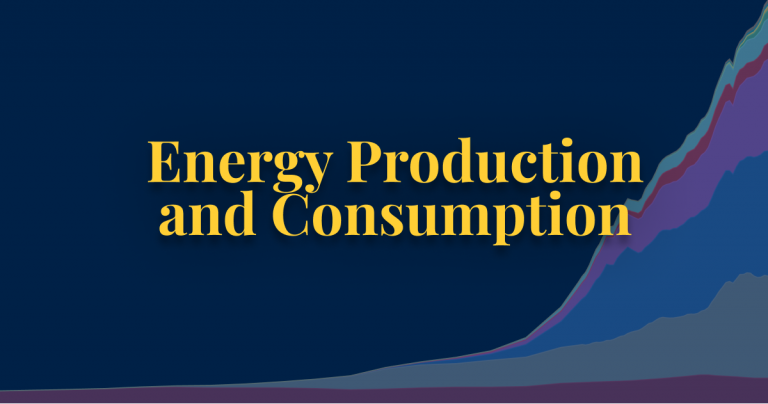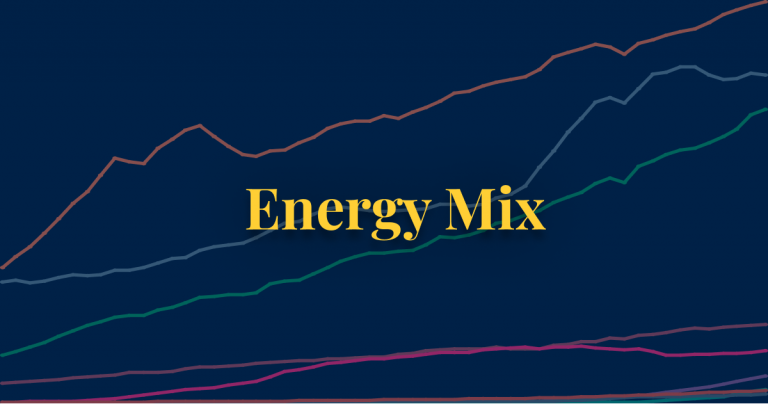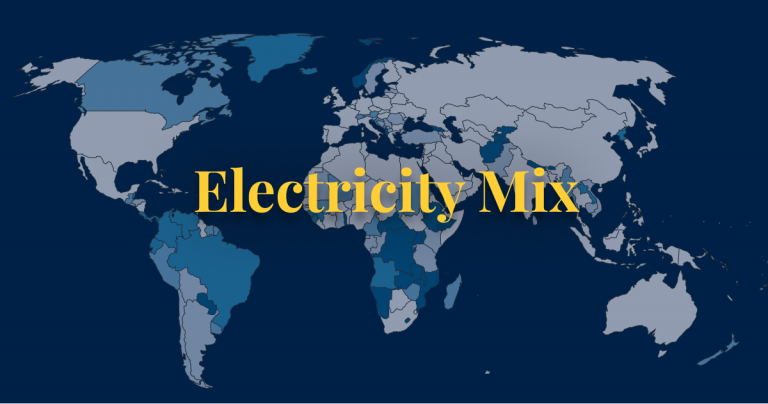Since the Industrial Revolution, the energy mix of most countries across the world has become dominated by fossil fuels. This has major implications for the global climate, as well as for human health. Three-quarters of global greenhouse gas emissions result from the burning of fossil fuels for energy. And fossil fuels are responsible for large amounts of local air pollution – a health problem that leads to at least 5 million premature deaths each year.
To reduce CO2 emissions and local air pollution, the world needs to rapidly shift towards low-carbon sources of energy – nuclear and renewable technologies.
Renewable energy will play a key role in the decarbonization of our energy systems in the coming decades. But how rapidly is our production of renewable energy changing? What technologies look most promising in transforming our energy mix?
In this article we look at the data on renewable energy technologies across the world; what share of energy they account for today, and how quickly this is changing.
All our charts on Renewable Energy
How much of our primary energy comes from renewables?
Related charts:
We often hear about the rapid growth of renewable technologies in media reports. But just how much of an impact has this growth had on our energy systems?
In this interactive chart we see the share of primary energy consumption that came from renewable technologies – the combination of hydropower, solar, wind, geothermal, wave, tidal and modern biofuels [traditional biomass – which can be an important energy source in lower-income settings is not included].
Note that this data is based on primary energy calculated by the ‘substitution method’ which attempts to correct for the inefficiencies in fossil fuel production. It does this by converting non-fossil fuel sources to their ‘input equivalents’: the amount of primary energy that would be required to produce the same amount of energy if it came from fossil fuels. We look at this adjustment in more detail here.
In 2019, around 11% of global primary energy came from renewable technologies.
Note that this is based on renewable energy’s share in the energy mix. Energy consumption represents the sum of electricity, transport and heating. We look at the electricity mix later in this article.
Two tips on how you can interact with this chart
- View the data for any country as a line chart: click on any country to see its change over time, or by using the ‘CHART’ tab at the bottom.
- Add any other country to the line chart: click on the Add country button to compare with any other country.
Breakdown of renewables in the energy mix
In the section above we looked at what share renewable technologies collectively accounted for in the energy mix.
In the charts shown here we look at the breakdown of renewable technologies by their individual components – hydropower, solar, wind, and others.
The first chart shows this as a stacked area chart, which allows us to more readily see the breakdown of the renewable mix, and relative contribution of each. The second chart is shown as a line chart, allowing us to see more clearly how each source is changing over time.
Globally we see that hydropower is by far the largest modern renewable source [since traditional biomass is not included here]. But we also see wind and solar power are both growing rapidly.
How you can interact with the stacked area chart
- In these charts it is always possible to switch to any other country in the world by choosing Change Country in the bottom left corner.
- By unticking the ‘Relative’ box, you can switch to see the breakdown of emissions in absolute terms.
How much of our electricity comes from renewables?
In the sections above we looked at the role of renewables in the total energy mix. This includes not only electricity, but also transport and heating. Electricity forms only one component of energy consumption.
Since transport and heating tend to be harder to decarbonize – they are more reliant on oil and gas – renewables tend to have a higher share in the electricity mix versus the total energy mix.
This interactive chart shows the share of electricity that comes from renewable technologies.
Globally, around one-quarter of our electricity comes from renewables.
Hydropower generation
Related charts:
Hydroelectric power has been one of our oldest and largest sources of low-carbon energy. Hydroelectric generation at scale dates back more than a century, and is still our largest renewable source – excluding traditional biomass, it still accounts for more than 60% of renewable generation.
But the scale of hydroelectric power generation varies significantly across the world. This interactive chart shows its contribution by country.
Hydropower in the energy and electricity mix
This interactive chart shows the share of primary energy that comes from hydropower.
Note that this data is based on primary energy calculated by the ‘substitution method’ which attempts to correct for the inefficiencies in fossil fuel production. It does this by converting non-fossil fuel sources to their ‘input equivalents’: the amount of primary energy that would be required to produce the same amount of energy if it came from fossil fuels. We look at this adjustment in more detail here.
In 2019, around 7% of global energy came from hydropower.
This interactive chart shows the share of electricity that comes from hydropower.
In 2019, around 16% of global electricity came from hydropower.
Wind energy generation
Related charts:
This interactive chart shows the amount of energy generated from wind each year. This includes both onshore and offshore wind farms.
Wind generation at scale – compared to hydropower, for example – is a relatively modern renewable energy source but is growing quickly in many countries across the world.
Installed wind capacity
The previous section looked at the energy output from wind farms across the world. Energy output is a function of power (installed capacity) multiplied by the time of generation.
Energy generation is therefore a function of how much wind capacity is installed. This interactive chart shows installed wind capacity – including both onshore and offshore – across the world.
Wind in the energy and electricity mix
This interactive chart shows the share of primary energy that comes from wind.
Note that this data is based on primary energy calculated by the ‘substitution method’ which attempts to correct for the inefficiencies in fossil fuel production. It does this by converting non-fossil fuel sources to their ‘input equivalents’: the amount of primary energy that would be required to produce the same amount of energy if it came from fossil fuels. We look at this adjustment in more detail here.
In 2019, around 2% of global energy came from wind.
This interactive chart shows the share of electricity that comes from wind.
In 2019, around 5% of global electricity came from wind.
Solar energy generation
Related charts:
This interactive chart shows the amount of energy generated from solar power each year.
Solar generation at scale – compared to hydropower, for example – is a relatively modern renewable energy source but is growing quickly in many countries across the world.
Installed solar capacity
The previous section looked at the energy output from solar across the world. Energy output is a function of power (installed capacity) multiplied by the time of generation.
Energy generation is therefore a function of how much solar capacity is installed. This interactive chart shows installed solar capacity across the world.
Solar in the energy and electricity mix
This interactive chart shows the share of primary energy that comes from solar power.
Note that this data is based on primary energy calculated by the ‘substitution method’ which attempts to correct for the inefficiencies in fossil fuel production. It does this by converting non-fossil fuel sources to their ‘input equivalents’: the amount of primary energy that would be required to produce the same amount of energy if it came from fossil fuels. We look at this adjustment in more detail here.
In 2019, around 1% of global energy came from solar technologies.
This interactive chart shows the share of electricity that comes from solar power.
In 2019, just over 2% of global electricity came from solar.
Biofuel production
Traditional biomass – the burning of charcoal, organic wastes, and crop residues – was an important energy source for a long period of human history. It remains an important source in lower-income settings today. However, high-quality estimates of energy consumption from these sources is difficult to find. BP’s Statistical Review of World Energy – our main data source on energy – only publishes data on commercially-traded energy, so traditional biomass is not included.
However, modern biofuels are included in this energy data. Bioethanol and biodiesel – fuel made from crops such as corn, sugarcane, hemp, and cassava – are now a key transport fuel in many countries.
This interactive chart shows modern biofuel production across the world.
Installed geothermal capacity
This interactive shows the installed capacity of geothermal energy across the world.
| SI Unit | Watt-hour (Wh) equivalent |
| Watt-hour (Wh) | – |
| Kilowatt-hour (kWh) | One thousand watt-hours (103 Wh) |
| Megawatt-hour (MWh) | One million watt-hours (106 Wh) |
| Gigawatt-hour (GWh) | One billion watt-hours (109 Wh) |
| Terawatt-hour (TWh) | One trillion watt-hours (1012 Wh) |
To maintain consistency between metrics and sources, we have attempted to normalise all energy data to units of watt-hours (Wh), or one of its SI prefixes. The table shows the conversion of watt-hours to the range of SI prefixes used.
- Data: BP publishes data on Oil, Gas Coal, Nuclear Energy, Hydroelectricity, Renewables, Primary Energy Consumption, Electricity Generation, Carbon Doixide Emissions
- Geographical coverage: Global – by country and region
- Time span: Annual data since 1951
- Available at: Online at www.BP.com
- Data: Historical Energy Consumption Statistics and Historical Energy Production Statistics
- Geographical coverage: Global – by country and world region
- Time span: Since 1900
- Available at: Both datasets are online at www.tsp-data-portal.org.
- Data: Data on electricity, oil, gas, coal and renewables. Data on CO2 emissions (also projections)
- Geographical coverage: Global – by country
- Time span: Last decades
- Available at: Online at www.iea.org
- The IEA is publishing the World Energy Outlook.
- You have to pay to access the IEA databases. But some data is available through Gapminder, for example Residential Energy Use (%). (for few countries since 1960, for more countries since 1971 or 1981)
- Data: Total and crude oil production, oil consumption, natural gas production and consumption, coal production and consumption, electricity generation and consumption, primary energy, energy intensity, CO2 emissions and imports and exports for all fuels
- Geographical coverage: Global – by country
- Time span: Annual data since 1980
- Available at: Online at ww.eia.gov
- EIA is a US government agency.
- Geographical coverage: Global – by country and world region
- Time span: Last decades
- Data: Energy use (kt of oil equivalent) – Energy use (kg of oil equivalent per capita) – Energy production (kt of oil equivalent)
- Many more related indicators.
- Data: Production & consumption of energy.
- Geographical coverage: Europe
- Time span:
- Data on: Energy production and imports – Consumption of energy – Electricity production, consumption and markets.










